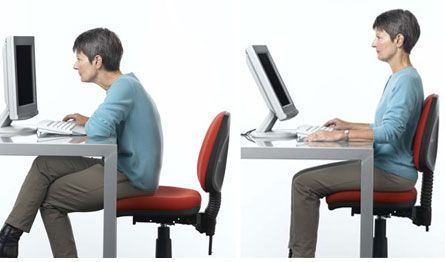By KC Reischerl, NSCA-PT
“Shoulders down! Shoulders back!” is the mantra I shout to my students. I shout it, I whisper it, I repeat it. Then I shout it again, I whisper it again and I repeat it … again. I say it in the hopes that whoever hears me will take those words and transform them into a living, breathing way of life, a way of understanding and using one’s shoulders. I say this mantra to many kinds of UCLA Bruins. Athletes, elderly, blue collar, white collar, faculty , staff and students alike. They’ve all heard me say it. Many of them, though, need to be reminded to do it. After watching shoulders up and forward for years, I’ve come to believe that a neutral shoulder is one of the keys to health and well being in the twenty-first century.
Before we can discuss how to correct misuse of the shoulder, we must first understand the definition of what makes a healthy or “neutral” shoulder. My favorite example of this is Leonardo DaVinci’s rendering of the human form, known as the Vitruvian Man.

If you look closely at the sketch you will see his palms are facing us. This is the quickest way I can illustrate to you how evolution has succeeded in giving our shoulders their optimal advantages. With the palms facing us, in their most relaxed or “neutral” state, two awesome things can happen:
We can internally and externally rotate our shoulders; i.e., move forward and backward, and we can elevate and depress our shoulders; i.e., move up and down. In a perfect world the shoulders would begin and end their duties maintaining a strong neutral stance. As we all know, however, this is not a perfect world.
 There are so many modern conveniences that pull us out of neutral shoulders! Computers, mobile phones, tablets, steering wheels, backpacks, strollers… you name it! Not to mention the primal instinct to pull our shoulders up around our ears when we are stressed, tired or afraid. With all these physical and mental distractions, and the sheer volume of time spent under these conditions, is it any wonder why so many people perceive elevated and internally rotated shoulders as the “new neutral”?
There are so many modern conveniences that pull us out of neutral shoulders! Computers, mobile phones, tablets, steering wheels, backpacks, strollers… you name it! Not to mention the primal instinct to pull our shoulders up around our ears when we are stressed, tired or afraid. With all these physical and mental distractions, and the sheer volume of time spent under these conditions, is it any wonder why so many people perceive elevated and internally rotated shoulders as the “new neutral”?
So, what to do? What to do? The first thing is to be aware of the problem. Right now you are probably sitting at a computer or reading this blog on a smart phone. And I’m guessing you’ve put your body in a position that looks much like the people in these pictures. Stop reading. Sit up and look straight ahead. Tuck your chin in a little and rotate your palms facing away from your torso. Drop your shoulders down. Even a simple step like this will remind you that curling over an electronic screen is not in your body’s best interest.
A few simple exercises can counteract the imbalances placed upon your shoulders. Here are two of my favorites:
Banded external rotation is a great opportunity for the posterior deltoid (back of the shoulder) to engage, as it is often underdeveloped when accompanied by a rounded upper back. Keep in mind when training the post delt that it is small and doesn’t need a lot of resistance or repetitions to get stronger. This little muscle will be so happy to be invited to the party and will do wonders for your posture.
Often we think our shoulders are down and away from our ears, but in fact they are hovering and slightly elevated. This can be incredibly taxing on the neck and upper back, especially if you are not aware you are doing it.
For this reason I often suggest shrugs. Shrugs may appear to lean into or exacerbate the notion of elevated shoulders, but there’s a method to my madness. Let’s look a little closer at fellow Bruin Liz in action:
When I ask a client or class member to shrug their shoulders up to their ears with dumbbells or reams of paper, I get a very specific response. I expect the shoulders to elevate. But on the eccentric or negative portion of the shrug , the shoulders truly lower, or depress, into a neutral form.
Often it takes the combination of the weighted prop and gravity to help remind us to truly lower the shoulders all the way down. For this reason I encourage the shrug as part of a healthy shoulder regiment.
The basic principles of “down and back “ can apply to many exercises. Anytime you are working with a barbell, kettlebell , dumbbell or resistance band and you are not going into an overhead movement ( a topic worthy of its own blog) remember: Shoulders down! Shoulders back!

This is great, thanks KC! I've been trying to work on my posture for a while now since I have a persistent pain / crick in my left shoulder (and pretty terrible posture...). For other BHIPers, if you haven't ever done so, I'd recommend looking at the UCLA Ergonomics website. If you are having aches and pains that you suspect are office-related, they'll do an on-site assessment and recommend better furniture, sitting postures, etc. https://www.irm.ucla.edu/ergonomics
ReplyDelete